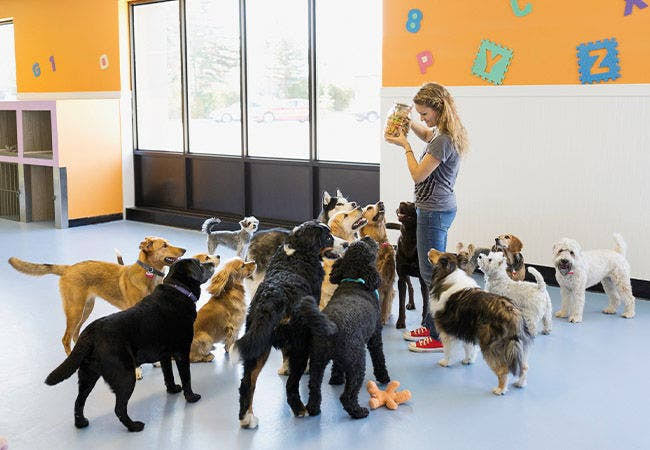Choosing the Right Doggie Daycare: Tips and Considerations
Key Takeaways
- Understand the importance of a good doggie daycare for pet well-being.
- Learn about essential factors to consider when selecting a facility.
- Explore tips for preparation before your dog’s first daycare visit.
- Discover ways to ensure ongoing positive experiences at daycare.
Understanding the Benefits of Doggie Daycare
In today’s fast-paced world, finding a suitable care option for your pet while balancing work and personal commitments can be challenging. Doggie daycare is ideal, catering to dogs’ physical and emotional needs. These facilities provide temporary boarding and a chance for dogs to engage with peers, promoting socialization. Research indicates that dogs regularly interacting with peers display improved behavior and reduced anxiety levels. Such environments are instrumental in keeping your furry friends active, healthy, and happy as they participate in playful activities and make new friends.
Factors to Consider When Selecting a Doggie Daycare
When choosing the right doggie daycare, various aspects must be evaluated to ensure your pet receives the best care possible. Start by looking into the qualifications and experience of the staff members interacting with your dog daily. A trained staff proficient in animal care and behavior can significantly enhance your pet’s daycare experience. Additionally, consider the facility’s infrastructure and safety measures. Is the environment clean and well-maintained? Are there safety protocols in place to handle emergencies? While initial visits might seem overwhelming, they are crucial in ensuring peace of mind. Facilities incorporating diverse activities, such as obstacle courses, pool play, or agility training, offer a more enriching experience, enabling dogs to use their energy constructively.
Preparing Your Dog for Their First Daycare Visit
Leaving your dog in a new place for the first time can be daunting. However, a few simple steps can make this transition smooth for you and your pet. Familiarizing your pet with car rides and short trips can ease their anxiety about the journey to daycare. Visiting the daycare beforehand also helps your pet get accustomed to the site’s smells and sounds, transforming it from unfamiliar to friendly territory. Ensuring vaccinations are up-to-date protects your dog and minimizes health risks to other pets. Pack a small bag with familiar items, like their favorite toy or a cozy blanket, to provide comfort and security in the new setting. Remember, the more calm and prepared you are, the more relaxed your pet will be.
Tips for Easing Transition
- Gradually increase the length of daycare stays, starting with half-day visits.
- Adopt a consistent drop-off and pick-up schedule that your pet can predict.
- Communicate any specific dietary or behavioral needs with staff for personalized care.
Ensuring a Positive Daycare Experience
Effective communication between pet owners and staff is the foundation of a successful daycare experience. Providing detailed information about your dog’s habits, preferences, and specific needs is critical. This insight enables staff to tailor care, ensuring your dog feels safe and valued. Regular feedback from staff about your dog’s activities and interactions at daycare can also put your mind at ease and help you assess if the facility meets your expectations and your pet’s needs. Establishing a rapport with staff members can foster trust and make you more comfortable being away from your pet throughout the day.
Signs of a Quality Doggie Daycare
A daycare facility’s quality can often be gauged by its level of transparency. Reputable centers are typically open about their operational processes and more than willing to answer any questions you might have. Cleanliness is another key indicator; a tidy, odor-free environment demonstrates attention to detail and a commitment to maintaining a healthy animal space. Daycares that adhere to stringent safety protocols, such as securing perimeters and monitored play sessions, prioritize your pet’s well-being. Moreover, accreditation from relevant organizations and glowing testimonials from fellow pet parents are invaluable in evaluating credibility. Regular visits and consistent reviews of the facility help ensure that high standards are continuously maintained.
Alternatives to Traditional Doggie Daycare
While daycare is an excellent option for many pet owners and their dogs, it’s not a one-size-fits-all solution. Some dogs may find a traditional daycare setup overstimulating or unsuitable due to unique needs. In such cases, pet owners might consider alternatives such as professional pet sitters who can provide personalized care in the familiar environment of your home. Additionally, incorporating advanced interactive toys or engaging tools like puzzle feeders and treat-dispensing balls can keep pets entertained and mentally stimulated at home alone. Tailor these solutions to best suit your dog’s personality and lifestyle for optimal results.
Common Concerns and Solutions
Common concerns, such as separation anxiety or potential injuries, are valid worries for any pet owner. Address these concerns during initial discussions with the daycare staff to ensure they can handle such issues. Well-trained, attentive staff can significantly mitigate the risks associated with communal pet environments. Encouragingly, many pet owners find that their dogs thrive in daycare settings once these initial concerns are addressed. Establishing a routine that revolves around your dog’s well-being, coupled with consistent feedback from the staff about their experience, reassures and empowers you as a pet owner, ensuring that your dog enjoys a safe, fun, and enriching environment while away from home.
Stay in touch to get more news & updates on Veri Fiedzine!






